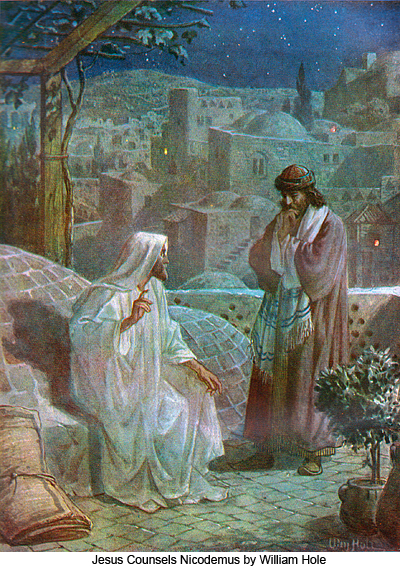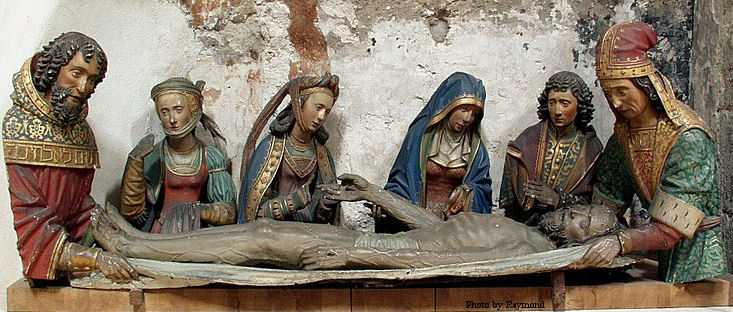St. Nicodemus
 A prominent Jew of the time of Christ, mentioned only in the Fourth Gospel. The name is of Greek origin, but at that epoch such names were occasionally borrowed by the Jews, and according to Josephus (Ant. of the Jews, XIV, iii, 2) Nicodemus was the name of one of the ambassadors sent by Aristobulus to Pompey. A Hebrew form of the name (Naqdimon) is found in the Talmud. Nicodemus was a Pharisee, and in his capacity of sanhedrist, (John, vii, 50) was a leader of the Jews. Christ, in the interview when Nicodemus came to him by night, calls him a master in Israel. Judging from John xix, 39, Nicodemus must have been a man of means, and it is probable that he wielded a certain influence in the
A prominent Jew of the time of Christ, mentioned only in the Fourth Gospel. The name is of Greek origin, but at that epoch such names were occasionally borrowed by the Jews, and according to Josephus (Ant. of the Jews, XIV, iii, 2) Nicodemus was the name of one of the ambassadors sent by Aristobulus to Pompey. A Hebrew form of the name (Naqdimon) is found in the Talmud. Nicodemus was a Pharisee, and in his capacity of sanhedrist, (John, vii, 50) was a leader of the Jews. Christ, in the interview when Nicodemus came to him by night, calls him a master in Israel. Judging from John xix, 39, Nicodemus must have been a man of means, and it is probable that he wielded a certain influence in the  Sanhedrim. Some writers conjecture from his question: “How can a man be born when he is old?”, that he was already advanced in years, but the words are too general to warrant such a conclusion. He appears in this interview as a learned and intelligent believer, but timid and not easily initiated into the mysteries of the new faith. He next appears (John, vii, 50, 51) in the Sanhedrim offering a word in defence of the accused Galilean; and we may infer from this passage that he embraced the truth as soon as it was fully made known to him. He is mentioned finally in John, xix, 39, where he is shown co-operating with Joseph of Arimathea in the embalming and burial of Jesus. His name occurs later in some of the apocryphal writings, e.g. in the so-called “Acta Pilati”, heterogeneous document which in the sixteen century was published under the title “Evangelium Nicodemi” (Gospel of Nicodemus). The time of his death is unknown. The Roman Martyrology commemorates the finding of his relics, together with those of Sts. Stephen, Gamaliel, and Abibo, on 3 August.
Sanhedrim. Some writers conjecture from his question: “How can a man be born when he is old?”, that he was already advanced in years, but the words are too general to warrant such a conclusion. He appears in this interview as a learned and intelligent believer, but timid and not easily initiated into the mysteries of the new faith. He next appears (John, vii, 50, 51) in the Sanhedrim offering a word in defence of the accused Galilean; and we may infer from this passage that he embraced the truth as soon as it was fully made known to him. He is mentioned finally in John, xix, 39, where he is shown co-operating with Joseph of Arimathea in the embalming and burial of Jesus. His name occurs later in some of the apocryphal writings, e.g. in the so-called “Acta Pilati”, heterogeneous document which in the sixteen century was published under the title “Evangelium Nicodemi” (Gospel of Nicodemus). The time of his death is unknown. The Roman Martyrology commemorates the finding of his relics, together with those of Sts. Stephen, Gamaliel, and Abibo, on 3 August.

St. Nicodemus, along with Our Lady, St. Mary Magdalene, St. John and Joseph of Arimathea, placing the body of Jesus in the tomb.
Conybeare, Studia Biblica, IV (Oxford, 1896), 59-132; Le Camus, La vie de N.-S. Jesus-Christ (Paris, 1883), I, 251 sqq.; II, 24 sqq., 577 sqq., tr. Hickey (3 vols., New York, 1906-08).
JAMES F. DRISCOLL








